White Sox first half strengths and concerns

FanGraphs currently gives the White Sox a 98.4% chance to make the playoffs, which would end an 11-year postseason drought. They also are given a 5.8% chance to win the World Series.
While it would take a huge collapse to not make the postseason at this point, there are both some aspects of the team that could prevent them from succeeding in October, and also some factors that could push them towards a division championship and beyond. The goal will be to maintain the strengths and tighten up the concerns as much as possible through this shortened season's second half.
Strength: Back end of the pen
Earlier this month, I outlined in detail how Evan Marshall and Jimmy Cordero have become diamonds in the rough for the White Sox. Marshall's changeup is still an elite pitch, and his command has remained impressive. He's upped his curveball usage, a pitch he had a lot of success with last season, another 12%. Movement metrics show us that it has above-average vertical and horizontal movement. Marshall's overall .265 xwOBA ranks in the 87th percentile this season, and he has yet to give up a barreled ball. With the injury to Aaron Bummer, he's played an even more important role over the past couple of weeks.
Prior to going down with that injury to his left bicep, Bummer was having a spectacular start to the season. He had an insane 78% ground ball rate and -11.9 degree launch angle. He'd begun to use his sinker 83% of the time, and it has the second-most vertical movement of any sinker in baseball. (If these kind of results continue for Bummer when he returns, the team should consider deploying a five-man infield when he pitches — though with Leury García's injury, the White Sox may not have the necessary personnel to do this. Still, it's an interesting consideration.)
Aside from the batted-ball results, Bummer was even getting 8% more whiffs with his sinker. There's no need to mess with much else when it's that good of a pitch. What Bummer has done over the last year-and-a-half is put himself in the upper echelon of relievers in MLB.
While some thought it wouldn't take long for Bummer to replace an eight-year veteran as the team's closer, Alex Colomé has beaten most of his expected regression thus far. Colomé's cutter velocity is actually down almost two mph, but he's gotten significantly weaker contact on it, with more horizontal movement and better command. Overall, Colomé's xwOBA is in the 87th percentile, and he's another White Sox reliever who has yet to give up a barreled ball. His O-Swing% is also up 12%, to 42%, which is by far the best of his career.
Concern: back-end of the rotation
With the trade deadline approaching, the back-end of the rotation is likely the area that GM Rick Hahn would look to address if he is looking to make a deal. The combination of injury and inconsistency has been the story for Dylan Cease, Reynaldo López and Carlos Rodón so far in 2020.
Gio González is a depth starter at this point in his career, but may be better suited as a swingman. He's pitched aptly to this point, but having to hand the ball to him in October probably isn't a great option. He's ditched his sinker for increased four-seam usage and has continued his late-career trend of throwing a changeup, his best pitch, more and more.
Cease is supremely talented and is coming off his best start of the season, at Wrigley Field. He made considerable strides with his control through the minor leagues, but his command struggles in the bigs are what's holding him back from being a really good starting pitcher.
Cease's arsenal starts with a high-spin, four-seam fastball that is consistently thrown at 97-99 mph. His velocity is up about one mph and his spin rate is up about 100 rpms, now in the 94th percentile in baseball. However, Cease's spin efficiency is only 74.7% (15th percentile), meaning that he has a lot gyroscopic spin that is killing the fastball's potential to have good vertical movement — it currently only gets 13 inches of rise. Even so, 74.7% represents a 9% improvement in spin efficiency from 2019. Nonetheless, at 98 mph, Cease can still be successful with his fastball if he can command it.
Changeup command has been a major issue this year as well, and Cease's has gotten hit hard. He creates plus movement on both his slider and curveball, but those could also be commanded better. He has the potential to remain in this rotation throughout his next five seasons of control, but with an xERA that's three runs higher than his ERA, he's a concern for the rest of 2020 at this point.
We haven't seen much of López yet, only four innings, so it's hard to pass too much judgment so far. His first start against Minnesota saw a fastball only averaging 92 mph, but after his IL stint he looked back to normal in sitting just a tick slower than 95 against the Cubs last weekend. López threw a well-below average quality fastball almost 60% of the time last year, and it had a .368 xwOBA and a .497 xSLG. He most often put it right in a hitter's wheelhouse.
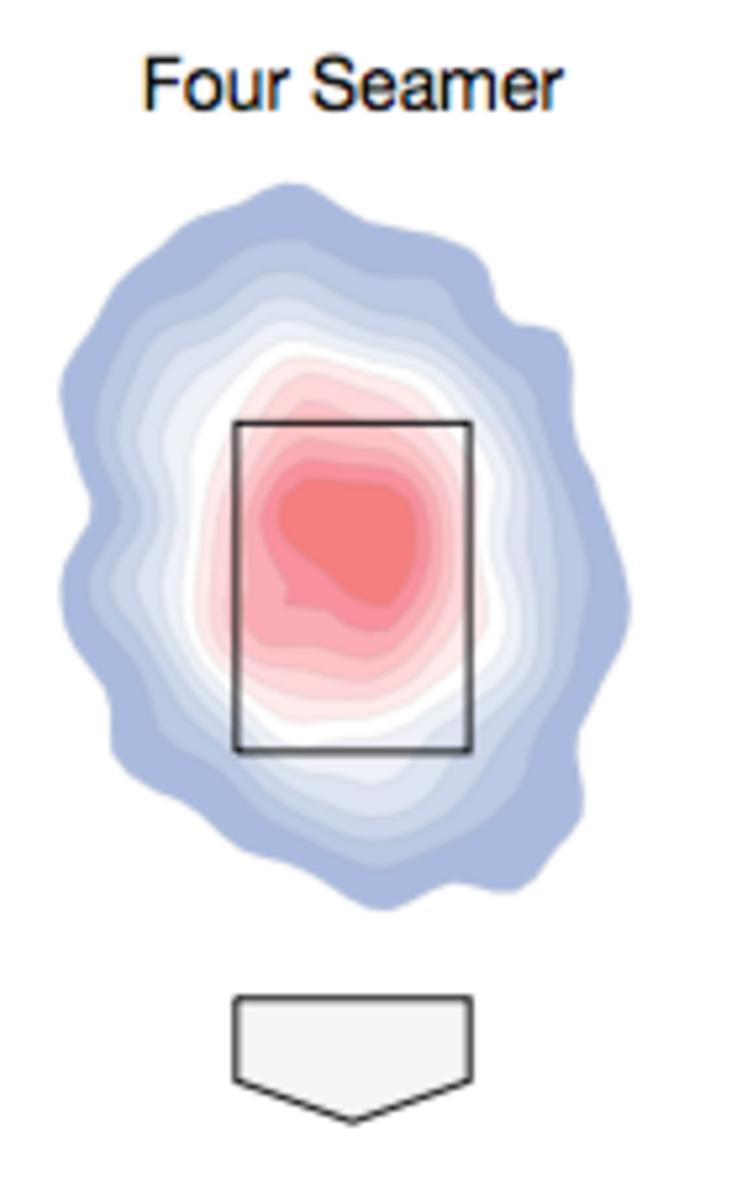
It will be interesting to see if and how López's role changes both this season and for the rest of his White Sox tenure. Whether it's in the rotation, the bullpen, as an opener of sorts, or even as a bulk reliever after an opener.
Utilizing him as a bulk reliever might be most effective; after an opener faces the top of a lineup in the first inning, López could face the bottom of the order twice while only facing the top once, in a three-to-five inning role every fifth day.
Rodón is another mystery, as to when he'll be back and what we'll get from him when he is back. His fastball has only been in the low-90s dating back to last season, and this year, his slider and changeup have been largely ineffective. I would not be surprised if Rodón is deployed in the bullpen once he's healthy enough to return. This would be with the idea that his fastball could play up, and he would only have to pair it with his slider, a pitch that was a big reason why he was once the No. 3 overall pick in the 2014 draft. Though it is now thrown about five mph slower than when he was drafted, Rodón's slider still has an encouraging movement profile. But if the quality of his secondaries improve from what we've seen, there's a chance he could be a viable back-end of the rotation option down the stretch.
Strength - rookie bullpen arms (plus Ross Detwiler)
Prior to the season, I predicted the White Sox would have an above-average bullpen, and this would be due to the aforementioned back-end guys, plus Steve Cishek and the potential of having Rodón and/or Michael Kopech as rotation hold-overs.
I was aware of Codi Heuer's potential, particularly his running fastball that creates "impact lateral movement". What I, and likely many others didn't see coming was Matt Foster showcasing an elite fastball, Zack Burdi pitching pretty well in his first cup of coffee in the major leagues, and BIG BOSS ROSS (ahem, excuse me, Ross Detwiler) not giving up a run through his first 12 ⅓ innings of the season.
Heuer sits in the upper-90s with his running sinker (two-seamer) and complements it with a slider that has been virtually untouched so far. His slider (24 pitches) has an .063 xBA, .064 xwOBA, 63.6 Whiff%, 70.4 exit velocity, and a -23 degree launch angle. That's great stuff.
As the 3D pitch chart below shows, while Heuer's sinker (orange) and his slider (yellow) don't tunnel as well as some other elite pitch combinations, both pitches break late. The pink dots show the hitter's commit point (about 167 ms before the plate), where he has to decide whether to swing. The plot shows a lot of the break taking place after the commit point, and this is contributing to Heuer getting whiffs and soft contact. The pitches break in opposite directions, and create difficult at-bats for opposing hitters.
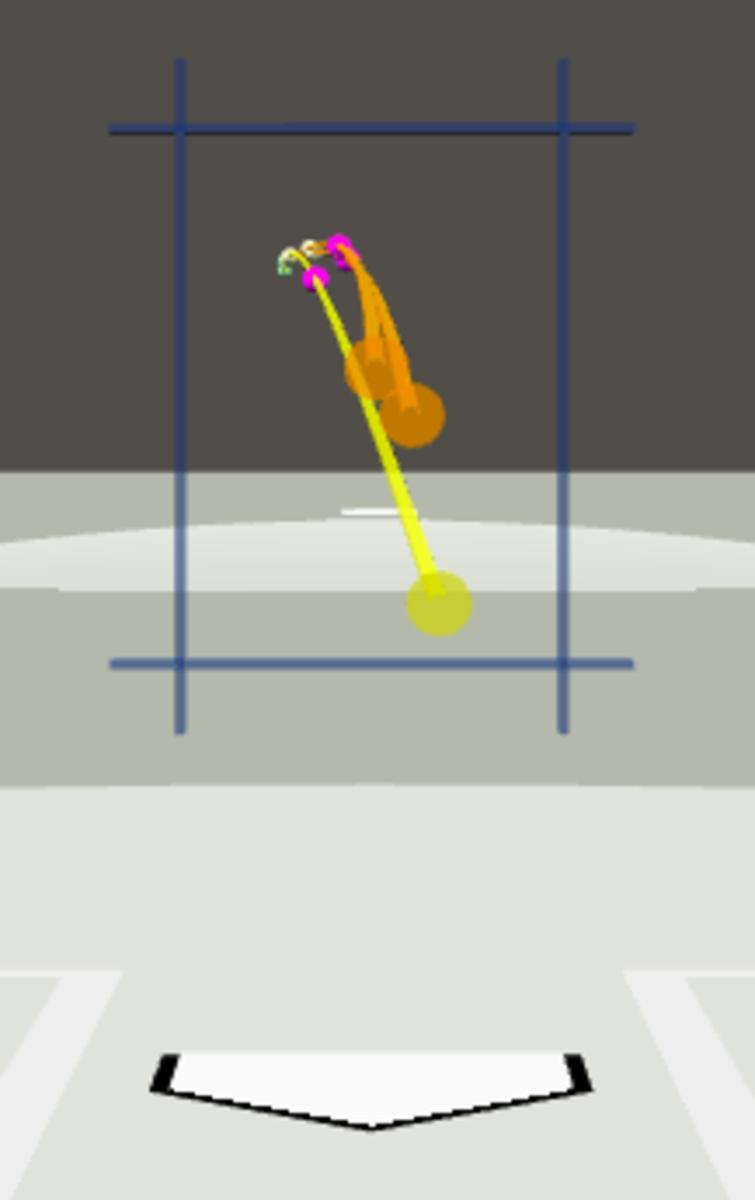
Foster's fastball is tough to hit. Even sitting at "just" 94 mph, it is tough to hit. He creates 13.1 inches of vertical movement (or 2.3 inches more than average), ranking in the 91st percentile in baseball. He also has mixed in a changeup and slider, with the former being his main secondary. It's no Marshall changeup, but it has gotten comparable results due to Foster's ability to play it off of his heater.
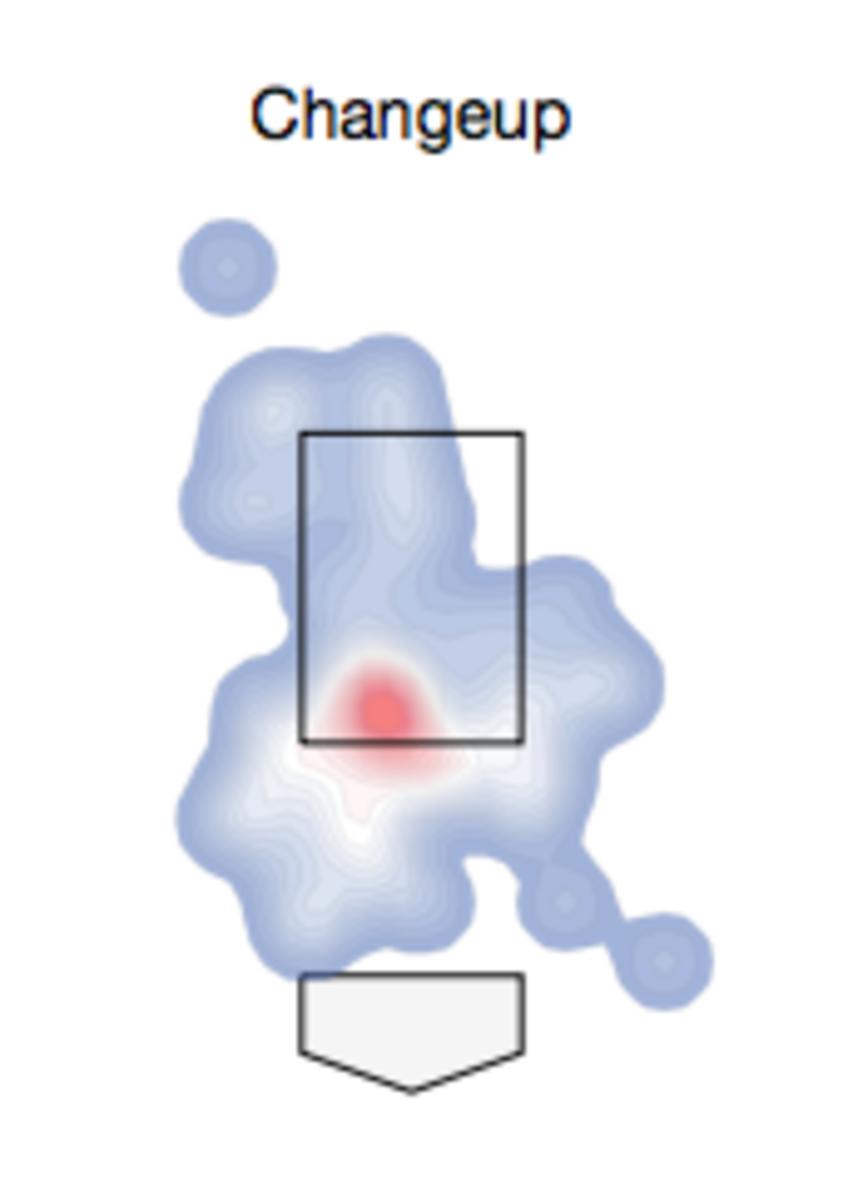
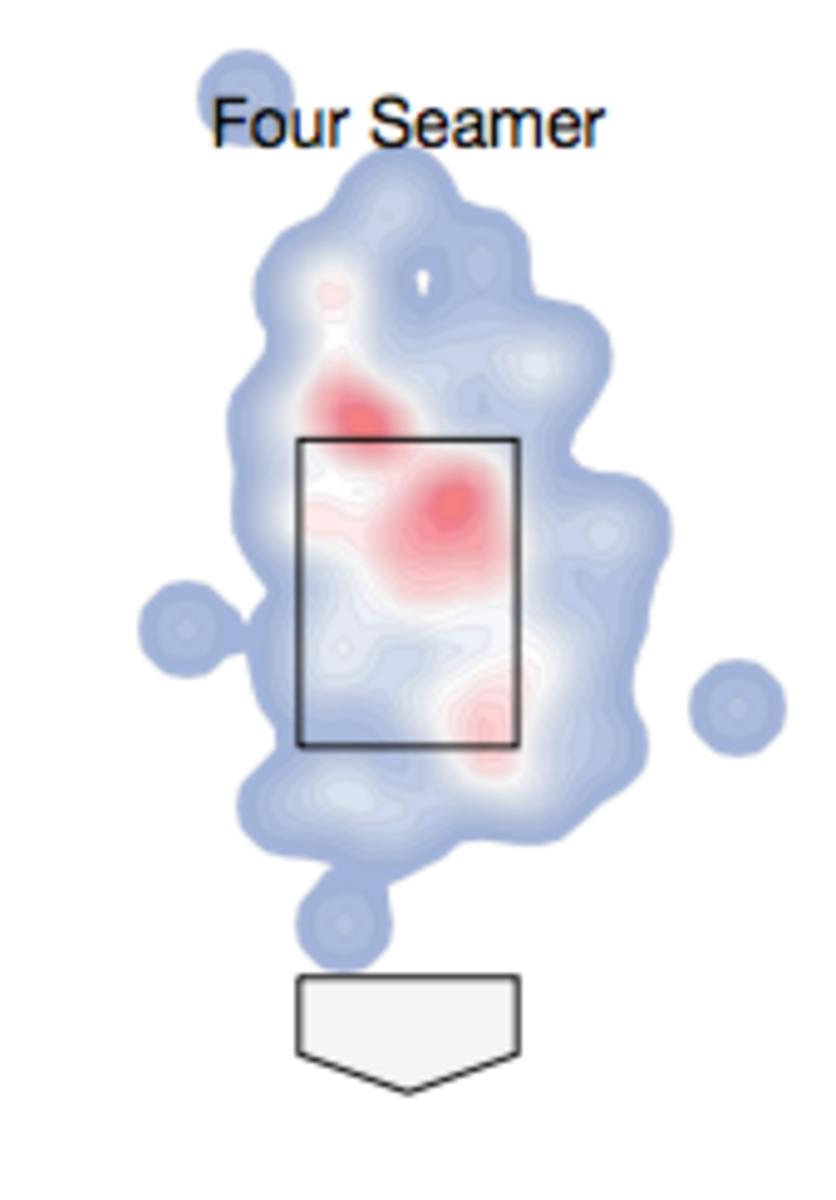
With Foster's ability to command his fastball at the top of the zone given the kind of spin he imparts, it forces hitters to adjust their attack angles. Getting on top of Foster's fastball, or at least having that approach as a hitter, is the only way to hit it. Even a well-commanded floating changeup with slight fade is going to be a challenge when Foster has an exploding fastball in his back pocket.
Burdi has only thrown six innings, but they have largely been good. Aside from mistakes to Paul Goldschmidt and Erik González, Burdi has flashed a fastball that sits 98-99 mph, with good run. In his most recent evaluation of Burdi this spring, Eric Longenhagen of FanGraphs saw Burdi sitting 94-96 mph with his fastball and a slider with decreased spin "not anywhere near the knifing 2700 rpm version from its peak." Burdi is now up to 2641 rpm, and getting plenty of whiffs with his slider so far in a small sample size. He looks to have fully recovered from his July 2017 Tommy John surgery.
Detwiler has a new slider he's been featuring this year. Last season he threw 22 of them, and they were hit to the tune of a .479 xwOBA and had only a 14.3 Whiff%. This year he's thrown 38 of them, with a .201 xwOBA and a 36.4 Whiff%. Detwiler has credited offseason right hip surgery (his landing side) as a big development for him, giving him a better ability to stay over his front side to execute his pitches. This also includes a higher spin rate on his four-seam fastball, along with a big spin efficiency improvement from 85.3% (57th percentile) to 93.5% (86th percentile). Better spin has created more horizontal and vertical movement on the pitch.
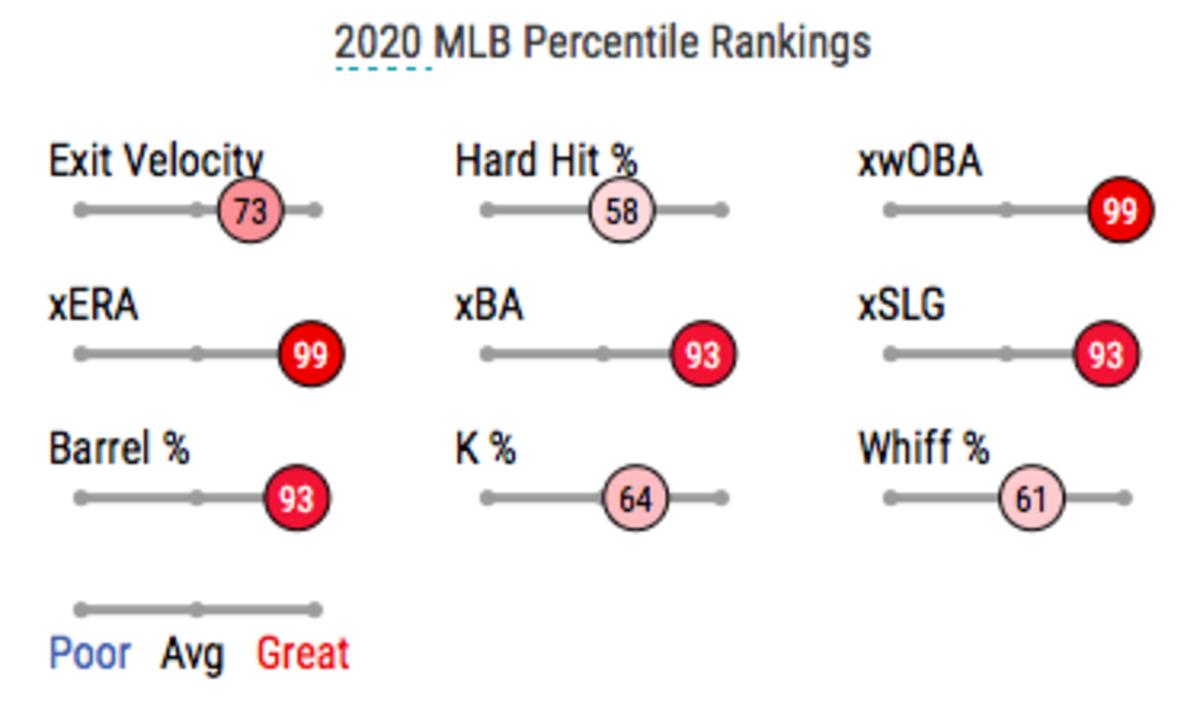
That's a lot of delicious red ink on his Baseball Savant page. Overall, he has a .172 xBA, .275 xSLG, .191 xwOBA (ranking third best in baseball) and 1.43 xERA, shown above as being in the top 1% of baseball.
Concern: Nomar Mazara
In fairness to Mazara, he only has 64 PAs — about 40 short of where he likely would be had he not started this season on the IL. However, he has not "broke out" yet, which is something the White Sox believed he could do when they traded for him back in December. He's hitting just .246/.328/.298, with a below-average .287 wOBA and 81 wRC+. That .246 average is also propped up by a .378 BABIP.
Mazara worked extensively with hitting coach Frank Menechino both in spring training and Summer Camp to revamp his approach at the plate. First, Mazara switched his hand position, which is clearly seen in this year's at-bats. He's also more open with his front foot.
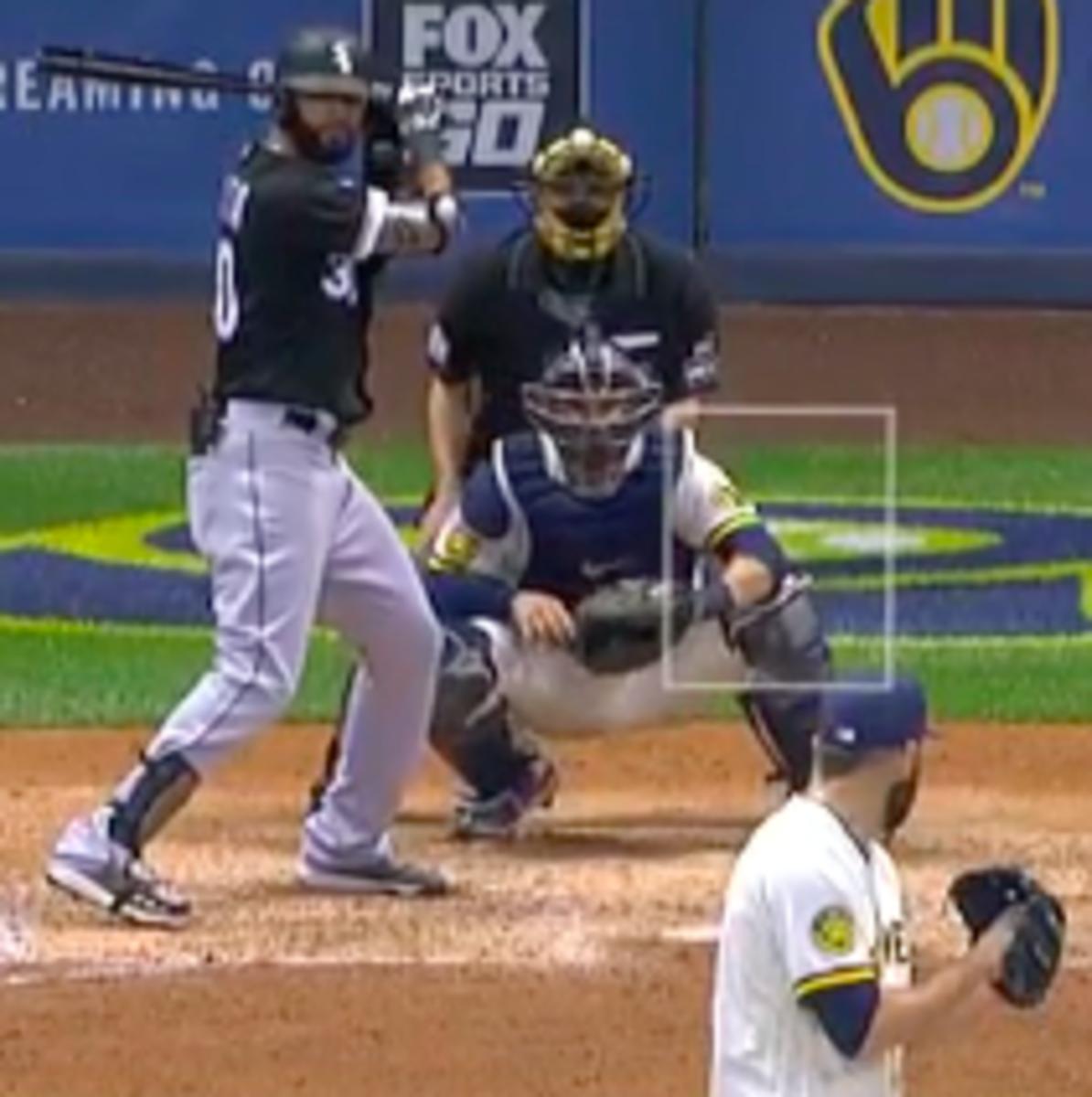
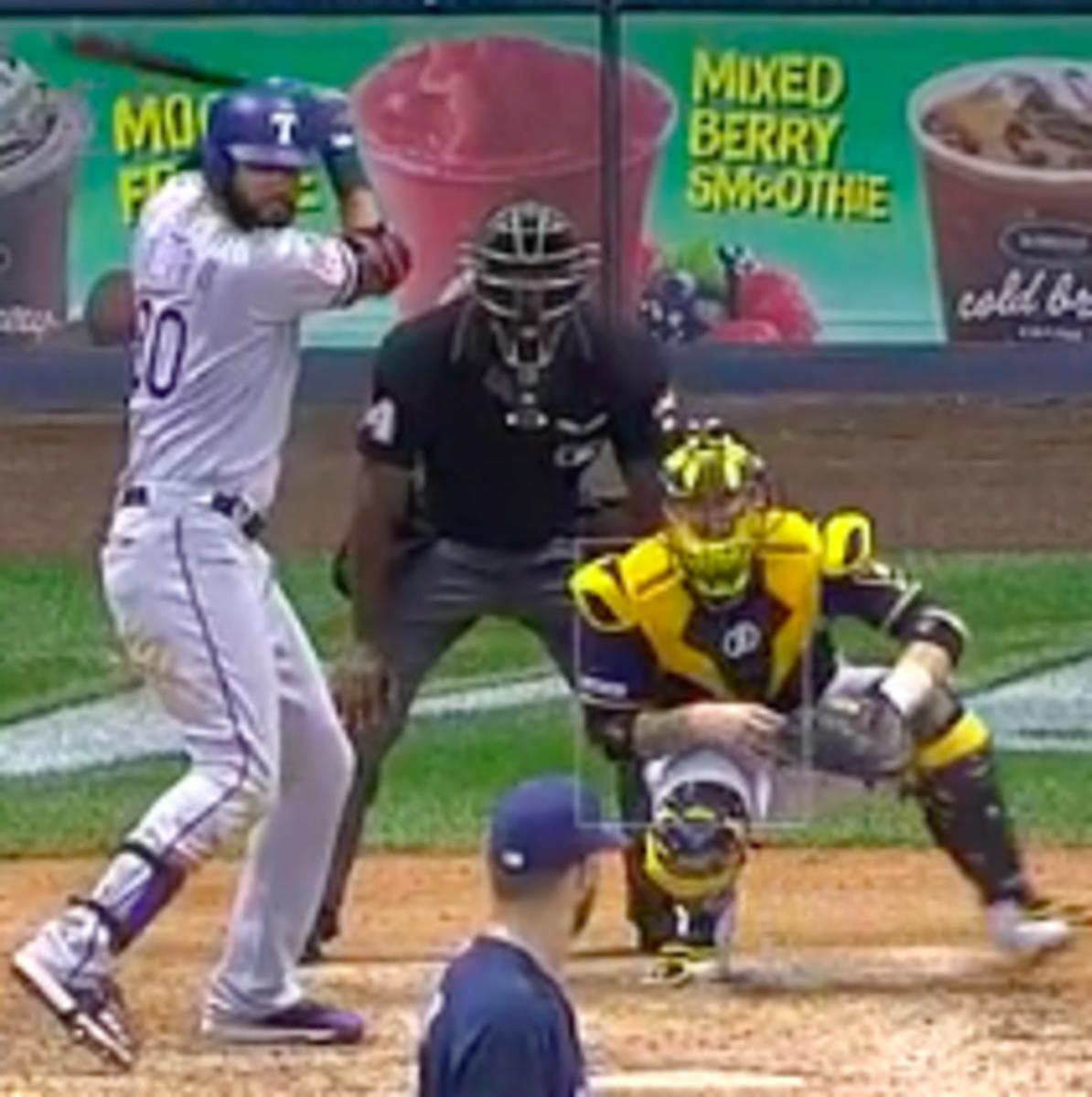
It's a stance that has seen different versions through Mazara's career. He also used to have a more pronounced pre-pitch bat-waggle that Menechino likely identified as problematic, as Menechino was quoted mentioning Mazara's improved bat-path. The basis of the changes were to simplify things to the point where he could take advantage of his sheer size and strength while also turning Mazara into a more "complete hitter."
Looking a little closer into his first 64 PAs, there are some things to like that may reflect some of these changes in approach. Mazara's O-Swing% is down 3%. His Z-Contact% is up 8%. His overall Contact% is up 2% and his SwStr% is down 2.5%. He's clearly been more selective, as signaled by a 5% drop in Swing%.
For some trends that are not welcome, Mazara's Z-Swing% is down 5% and now sits below average. His launch angle, which is a metric that has been identified as an issue with Mazara, is down from 10.4 degrees to 4.8 — and this was a number that we hoped would be climbing.
It looks like some unintended consequences of this increased effort for selectiveness are seen in his batted-ball profile. Mazara has been fisting (and getting a surprising amount of hits on due to shifted infields) a good amount of pitches inside and middle-in, where he is just seemingly late, softly poking them the other way. His Oppo% is up more than 16% to 45.5%, which is second in baseball behind only Tampa Bay's Yandy Diaz (who, interestingly enough, has had similar batted-ball profile issues that the Rays have worked with him to fix).
When analyzing exit velocity and launch angle, it's best to look at a hitter's launch angle on hard-hit balls (balls hit at least 95 mph). In 2018, Mazara's launch angle on hard-hit balls was a measly 6.6 degrees. He was able to raise it to 13.5 degrees in 2019, and this improvement likely caught the eyes of the White Sox front office. That rate was similar to Yasmani Grandal, José Altuve, Nolan Arenado, and Nelson Cruz. So far in 2020, Mazara's is back down to exactly 6.6 degrees. That puts him near what players like Eric Hosmer, Albert Almora Jr., José Iglesias and José Rondón showed in 2019.
Finally, one specific aspect that Mazara is struggling with is his ability to handle pitches down and in. He loved those pitches last season, but this year he has yet to put a single one in play.
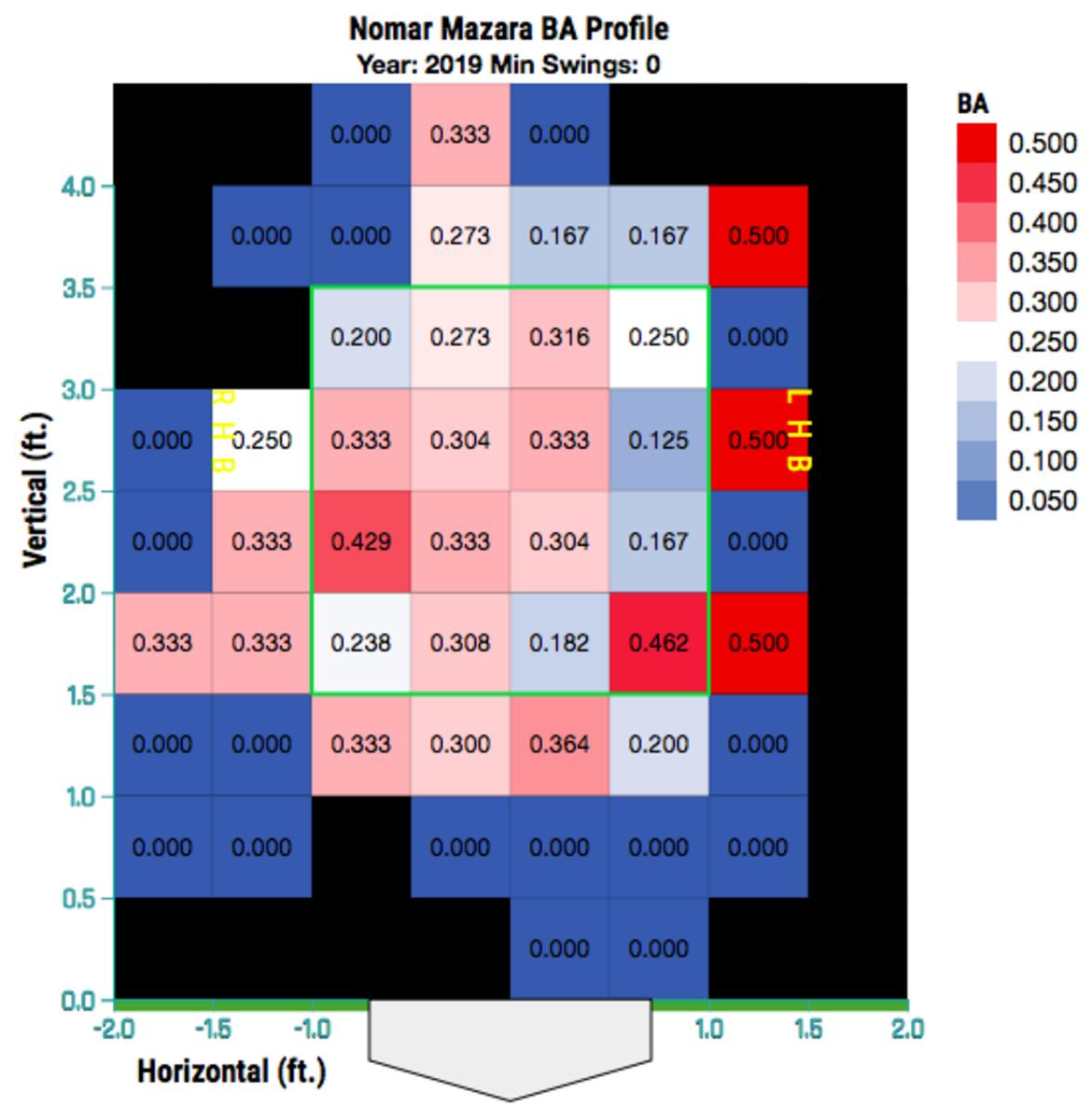
Nomar, newly a "complete" hitter or not, we're just asking for you to mix in a couple of these.
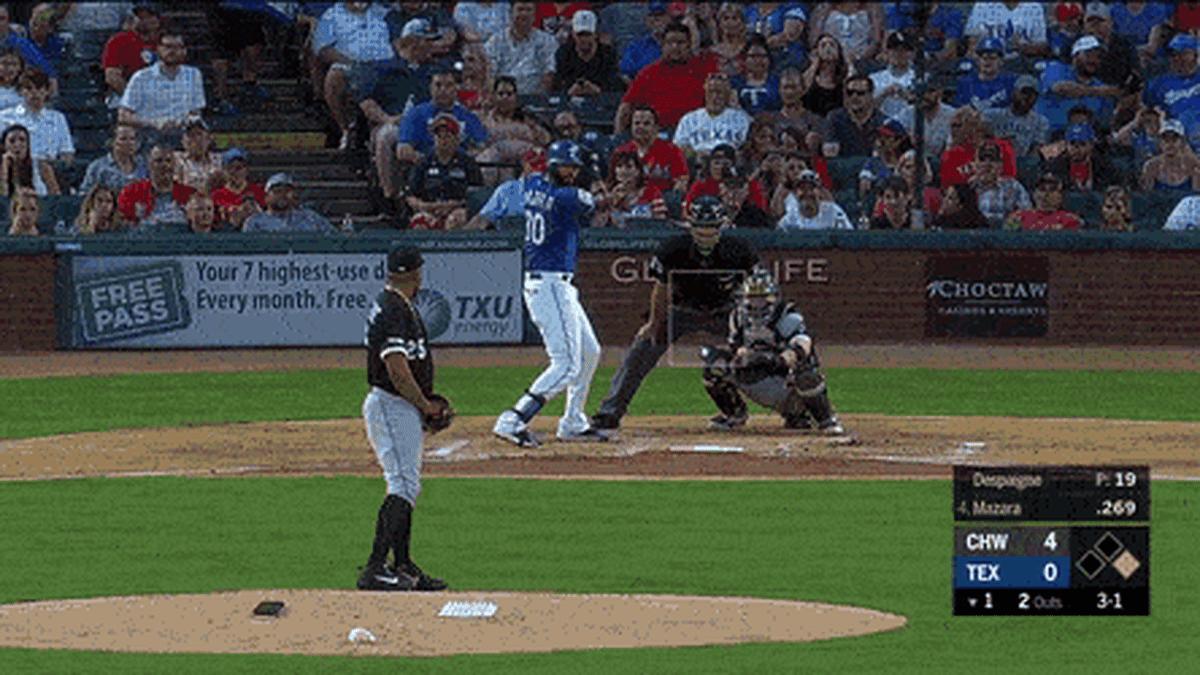
Mazara was really good at dropping the head of the bat and crushing pitches like what he did against Odrisamer Despaigne. Power-hitting lefties are known to feast on pitches in this zone. In the same zones where Mazara hit better than .460 in 2019, he's whiffed at virtually all this year. On pitches down-and-in this season, Mazara has whiffed at 11 of 16 pitches swung at, with the other five being foul balls. That 68.8 Whiff% on those pitches is up 20% from last year.
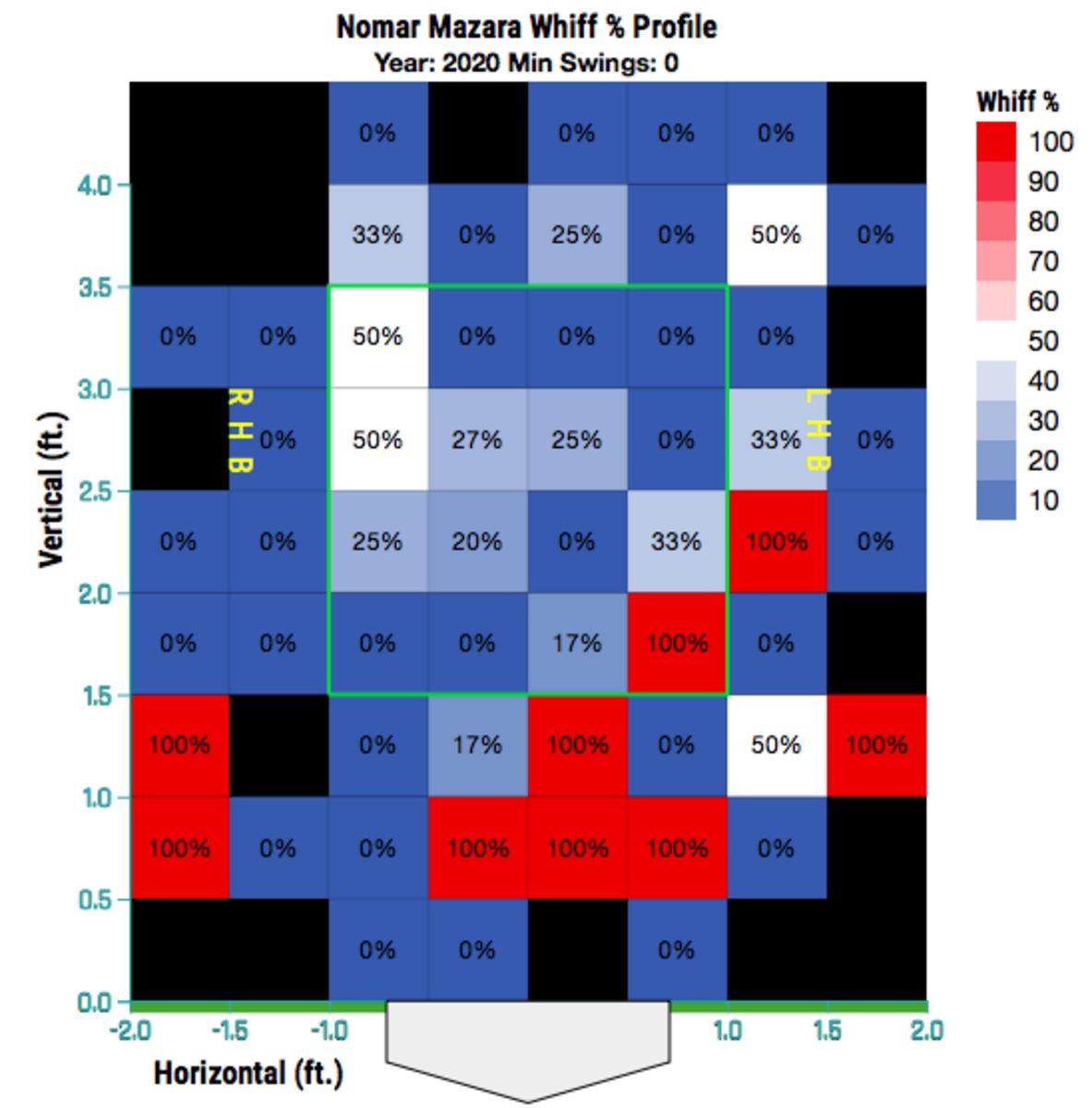
Is this a result of his new approach? It very well could be, but one other important thing to consider in Mazara's uninspiring first half is that we are still only talking about 60 PAs and 33 BIPs. Making significant judgments based solely on his 2020 opportunities is ill-advised. Seeing another 40-50 plate appearances and 20-30 BIPs should raise our confidence level in these results.
The problem with this shortened-season is that in the time it takes for these metrics to normalize, the White Sox will have to ride with whatever he's providing for a large chunk of the season while waiting for the upside to shine through. We'll have to continue to be patient, and Mazara's second half will also have a lot to do with whether or not his contract is tendered for 2021.
Strength: Lucas Giolito and Dallas Keuchel
Lucas Giolito is a bonafide ace, and Dallas Keuchel is a good No. 2. Giolito is coming off the most dominant outing in recent team history with Tuesday's No-No. He's managed to improve on his 5-WAR 2019 season so far. While Detroit and Pittsburgh are likely their respective league's worst teams, Giolito's last two starts have seen him give up a total of three hits, zero earned runs, and two walks while striking out 26 over 16 innings, with a 1.26 xFIP.
Giolito's fastball and changeup have been just as good as they were last season. His slider and curveball (in a small sample) have been better. The 2020 season marks the second consecutive one where Giolito has taken spin off of his changeup, which is good. What makes the pitch as successful, as it is is not the movement, it's the conviction with which he throws it. He doesn't change his arm speed or arm angle at all, and the pitch has a 13 mph velocity difference on average. Another noticeable improvement Giolito has made is an almost 11% increase in ground ball rate. Better changeup location is a big part of this.
To round out his value to this team, fellow pitchers (such as López on Saturday) have been seen flocking to Giolito after their outings to presumably explain their approach to the situation and get his feedback; Giolito has asserted himself as the captain of this pitching staff.
Finally, his ability to articulate his outings, pitch-to-pitch, gives us fans (and myself as an analyst) a sense of perspective and frankly, confidence, that he has a supreme understanding of what it takes to be an ace.
The best word to describe Keuchel this season is dependable. He's given the Sox a chance to win every time he's taken the mound, despite his stuff not being as sharp as last season. His velocity and vertical movement are down on his sinker and he's getting about 10% fewer ground balls when it's contacted. Overall, Keuchel's launch angle is up from 2.9 degrees to 4.3, and his ground ball rate is down 2.6%. In his Cy Young 2015 season, it was 1.1.
Keuchel should be due for at least a little negative BABIP regression. However, his exit velocity is down about two mph, and league BABIP is down nine points. Keuchel's fantastic control has also been a welcome addition to a White Sox rotation, as his 2.08 BB/9 is his lowest since that 2015 season with Houston.
Concern: Edwin Encarnación and Steve Cishek
In Encarnación's last eight games, he is hitting .233/.343/.667 with a .412 wOBA and a 166 wRC+, so he's looked better as of late. His .149/.184/.277, .200 wOBA, 22 wRC+ before this stretch, however, should not be ignored. As it eventually happens with virtually all hitters who are good enough to play in their late-30s (but apparently not Nelson Cruz), it looks as though EE has lost some bat speed. Usually when this happens for a hitter, we see a drop in Z-Contact% (down 6%), with slower hands combined with a higher O-Swing% (up 4%) as the hitter begins to compensate by committing to swing earlier. Both of these are present with Encarnación.
Renteria has recently commented that he thought Encarnación wasn't lacking any of the "quick twitch" abilities to still have a successful rest of the season. He alluded to the notion that he just needed more at-bats to lock in. On fastballs this season, Encarnación is hitting .083 (2-for-52) with an 83.9 mph exit velocity and a 32.4 degree launch angle. The expected batting average of balls hit that hard and at the angle since 2015? Roughly .023. On fastballs thrown at least 94 mph, Encarnación has zero hits on 17 swings and has put only one of those into play.
Encarnación has bought himself plenty more opportunities with his performance over the last week, but when considering whether or not to potentially add a rental bat prior to Monday's trade deadline, there are certainly some worrisome signals.
Cishek is another free-agent addition who has not lived up to expectations so far, but has also been better in recent outings. In his last six appearances dating back to August 10, Cishek has a 1.80 ERA and a 2.36 FIP, with better peripherals across the board. This includes improvements in O-Swing% (7%), F-Strike% (23%), SwStr% (2%) and Barrel% (5%). (On August 9, he had a 11.12 ERA and a 9.34 FIP.)
In 2019, Cishek had the second-best average exit velocity among qualified (BBE) pitchers. With the new three-batter minimum rule implemented this season, I was somewhat uneasy about the fact that he'd likely be facing more lefties than ever before. Left-handed hitters, while still not good, had a 52-point wOBA advantage against him compared to righties (.302 vs. .250). However, the concerning fact about Cishek in this small sample of 51 hitters faced is that it's righties who are hitting .357/.419/.643 against him, with a .448 wOBA. Lefties currently carry a .273 wOBA against him. Luckily, the Sox have had other options this season, allowing them to bring Cishek along in low-leverage situations.
Strength - the lineup as a whole
According to FanGraphs' fWAR, the White Sox have had the best team of position players in baseball through the first half of the season. They are a full win better than the next highest, the Los Angeles Dodgers. They lead in team wOBA (.349), wRC+ (123), batting average (.270) and slugging (.490), the latter by 16 points over the next-best Dodgers. They're second in barrel rate (Padres), third in ISO (Dodgers and Padres) and have the second most home runs, with 59 (Dodgers).
Concern - plate discipline
My thoughts published last week on the White Sox plate discipline issues were likely forgotten as the team went on a historic home run streak right after. While the concern still holds to a certain extent, we have seen better approaches at the plate recently. The Sox have worked deeper into counts and have found their way into bullpens sooner.
Through the first 21 games, the Sox had the league's fourth-worst O-Swing%, and third worst SwStr%. They had the ninth-best position player group and had a league average offense overall (100 wRC+).
Over the last 10 games, the Sox have nine wins, and their position players have been a win-and-a-half better than any other team. They've hit .311/.366/.648, with a .419 wOBA and a 171 wRC+, 29% better than the next-best Padres over that span. Chicago's 32 homers is 10 more than the second-best Dodgers and Blue Jays.
So they've had to be swinging at less pitches out of the zone, right? Actually not; they've only been better than the Marlins and Orioles in terms of O-Swing% over the past 10 games. In fact, they've gotten slightly worse. What they did improve on was their Z-Contact%. They went from 81.8% (27th) to 86.8% (fifth). Not only has it been contact, it has been good contact, as they've had the highest barrel rate in baseball since August 16. If they have this much success with pitches in the zone, then their O-Swing tendencies will be overshadowed.
Plate discipline is still a concern, because it's unlikely that the White Sox will be able to sustain this kind of contact. If and when it slows down, they could fall back to where they were in early August. Good pitchers will adjust and force Sox hitters to lay off pitches out of the zone.
Strength: defense
According to Sports Info Solutions, as of Wednesday morning, the White Sox defense ranks No. 1 in MLB in Defensive Runs Saved. As for how exactly that breaks down, this tweet from their account puts their performance in perspective compared to some of the other league bests.
It's the White Sox who lead the way in Defensive Runs Saved this season
— SIS (@SportsInfo_SIS) August 26, 2020
Top 10 teams in the image pic.twitter.com/nf0zaDi23O
Center field stands out, as Luis Robert already has eight DRS. He makes it look so easy out there, and he has validated the "La Pantera" nickname quite well. This is also backed up by Baseball Savant's Outs Above Average metric that puts Robert in the top 1% of all major league outfielders defensively. OAA is considered a more comprehensive defensive metric.
The catching tandem of Grandal and James McCann, José Abreu at first, Danny Mendick at second, and Tim Anderson/Leury García at short have all been really good as well. Abreu was at negative eight DRS last season, and Anderson was at -12. Mazara and Adam Engel have provided value in right field. Yoán Moncada at third and (expectedly) Eloy Jiménez in left, have been below-average in terms of DRS.
---
The first half has to be described as a successful one, with the White Sox putting themselves in prime position for a playoff berth. Getting some important players back and healthy, plus a potential trade acquisition before next week's deadline, should only help. The last week has shown us how good the current team can be, and how they can continue to surprise people through this year's postseason.
